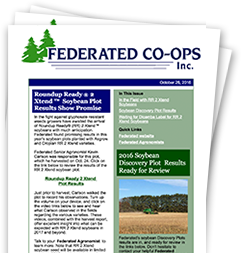The Challenge of Interpreting Discovery Plot Results

Federated’s Discovery Plots yield invaluable information for Federated growers because they provide local data in real time. Plot harvest concluded in the past two weeks and results have been compiled and posted here.
Plot results are always helpful, but this growing season added some challenges to interpreting the wide-ranging data.
What are the major takeaways from this year’s soybean and corn plots? Kevin Carlson, Federated’s agronomy sales manager, offered these perspectives.
Soybean Plots and White Mold
The soybean plots had average yields, but white mold was evident in more than one plot (and on many fields across Federated’s service areas). This was a significant underlier in plot yields, and the only reason yields held up, “in my professional opinion,” said Carlson, is because the seed genetics had some tolerance to the disease. Not resistance, he said, but tolerance. However, that being said, it’s not at all wise to rely on tolerance alone.
White mold is “taking a lot of yield, in bushels, across the territory,” Carlson said. “It’s formally recognized that once you approach 40% [white mold] incidence in a field, that is significant when it comes to yield. We were there . . . with a pretty high infection rate but yields still held together pretty well. We lost some yields . . . it’s hard to put a number on that . . . maybe 10 bu./ac. top to bottom, easily 5 bu./ac.”
Carlson noted that white mold is quickly becoming the #1 disease concern in Federated areas, so “we have to use all the management tools we have to reduce white mold incidence, infection, and yield loss.” All the varieties in the plots were affected by white mold to some extent, and that won’t improve over time without good management. “We’ve had ideal white mold environments [in the past few years]: more pressure, a susceptible host . . . it’s just a matter of how susceptible.”
Understanding the disease is important in formulating a plan. “It’s a little more complicated to manage than what meets the eye.” Your Federated Agronomist is ready to help make those plans.
Corn Plots Better than Expected
The corn plots (and the corn crops overall) were “a little better than expected, all things considered,” but the harvest definitely “didn’t finish on the high note” of the past few years.
“The cool ending took test weight, quality, and total weight right off the top on a lot of our plots,” said Carlson. The lighter soils did fairly well, but all the plots still had some of the same issues. Once the black layer developed, Carlson noted, the weather got worse. The corn was 5-10 points dryer last year; corn from this year’s plots was in the 20-25 moisture range.
“GDUs were a little short (200-300 short) so the crops couldn’t fully mature or dry,” he said, and the warmer temperatures that showed up in late September weren’t very helpful. “One GDU in late September is not the same as a GDU in early August,” thanks to shorter days.
Making Sense of the Data
Carlson’s final observation on the plots came down to this: Take the data from this year’s plots and combine it with that of the past couple of years. Don’t discard a product’s potential based on 2019 alone. “Look at multi-year data,” he said. As for brand new products, “it’s not a great year to make a final decision on the product.”
“I understand fully that we need products that perform year in and year out on a very consistent basis, and that is what the plots are for, to help filter out inconsistent products,” said Carlson.
Growers may need to spend a little extra time interpreting the results in order to make good decisions for the 2020 season. Your Federated Agronomists are ready to help you sort it through. Give them a call.


